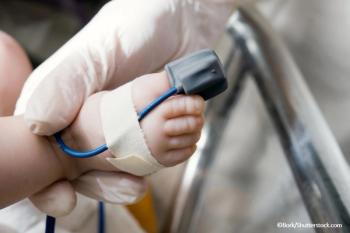
Images in HIV/AIDS
Salivary gland enlargement, most commonly involving one or both parotid glands, is sometimes seen in association with HIV infection. Enlargement of the parotid gland may be due to diffuse infiltrative lymphocytosis syndrome; lymphoepithelial cysts; or malignant tumors, such as squamous cell carcinoma, Kaposi sarcoma, and Hodgkin and non-Hodgkin lymphomas.1,2 Non–HIV-related causes of parotid enlargement include acute and chronic viral infection, granulomatous disease, malnutrition, alcoholism, and diabetes mellitus.3,4 Here we report the case of a 41-year-old HIV-infected man with fat maldistribution syndrome associated with type 2 diabetes and hyperlipidemia. Sialadenosis developed presumably as a result of HIV infection and hypertriglyceridemia.
Salivary gland enlargement, most commonly involving one or both parotid glands, is sometimes seen in association with HIV infection. Enlargement of the parotid gland may be due to diffuse infiltrative lymphocytosis syndrome; lymphoepithelial cysts; or malignant tumors, such as squamous cell carcinoma, Kaposi sarcoma, and Hodgkin and non-Hodgkin lymphomas.1,2 Non–HIV-related causes of parotid enlargement include acute and chronic viral infection, granulomatous disease, malnutrition, alcoholism, and diabetes mellitus.3,4 Here we report the case of a 41-year-old HIV-infected man with fat maldistribution syndrome associated with type 2 diabetes and hyperlipidemia. Sialadenosis developed presumably as a result of HIV infection and hypertriglyceridemia.
The patient's HIV infection was diagnosed in 1987. He began antiretroviral therapy comprising zidovudine, lamivudine, and efavirenz in 1999, when his CD4+T-lymphocyte count fell below 300/µL and his HIV RNA level increased above 100,000 copies/mL. Over the next 4 years, he maintained a CD4+ cell count greater than 500/µL while his HIV RNA level remained less than 75 copies/mL. Even though he adhered to a diet for persons with diabetes, by 2003 his hemoglobin A1c level was 8.4% (normal, 4.0% to 6.0%) and his fasting serum total cholesterol and triglyceride values were 155 mg/dL and 481 mg/dL, respectively (normal, less than 200 and 150, respectively).
After initiation of metformin, pravastatin, and fenofibrate and despite improvements in blood glucose homeostasis and lipid profiles, the patient complained of increasing abdominal girth, thinning of his extremities associated with prominent vascularity, development of a dorsal neck lump, and thickening of his neck (Figure 1A and 1B). Zidovudine and lamivudine were replaced with tenofovir and emtricitabine, but he soon became distressed by progressive and bilateral parotid gland enlargement in the absence of sicca syndrome or pain (Figure 1C).
A CT scan of the abdomen showed signs of a fatty liver. A CT scan of the head and neck showed diffuse parotid gland enlargement without cystic lesions or obvious fatty infiltration (Figure 2). A laboratory workup showed normal results for complete blood cell count, chemistry panel, and thyroid function tests; serologic tests negative for viral hepatitis; and normal free serum testosterone, cortisol, and adrenocorticotropic hormone levels. Results of serum protein electrophoresis and tests for autoantibodies to rheumatoid factor, antinuclear antibody, and single- and double-stranded DNA were all unremarkable. The patient's most recent hemoglobin A1c was 6.1%; his fasting total cholesterol level was 142 mg/dL (high-density lipoprotein cholesterol level, 31 mg/dL; low-density lipoprotein cholesterol level, 79 mg/dL); and his serum triglyceride level was 142 mg/dL. Examination of a parotid gland core needle biopsy specimen demonstrated dense fibrosis and extensive fatty infiltration within the gland with no lymphocytic foci, malignancy, or inflammation (Figure 3).
Bilateral parotid gland enlargement, with or without sicca syndrome, may occur secondary to hypertriglyceridemia.5 In this setting, enlargement and dysfunction may be due to fatty infiltration of the parotid tissue. This sialadenosis is occasionally reversible with optimal management of hyperlipidemia. Healthy lifestyle changes, including exercise and diet adjustment, are important in managing hyperlipidemia. Oral hypoglycemic agents (ie, statins and fibrates) are also important components in optimizing diabetes and lipid management.6 Some antiretroviral regimens may further complicate HIV treatment by exacerbating underlying diabetes and hyperlipidemia, which presumably contributed to this patient's parotid enlargement.7
There are no assurances that medical management will reverse parotid gland enlargement. A superficial parotidectomy may be considered if parotid enlargement persists despite optional management of the metabolic syndrome that is associated with both HIV infection and diabetes mellitus.
References:
References
1. Williams FM, Cohen PR, Jumshyd J, Reveille JD. Prevalence of the diffuse infiltrative lymphocytosis syndrome among human immunodeficiency virus type–positive outpatients. Arthritis Rheum. 1998;41:863-868.
2. Zeitlen S, Shaha A. Parotid manifestations of HIV infection. J Surg Oncol. 1991;47:230-232.
3. Rice DH. Noninflammatory, non-neoplastic disorders of the salivary glands. Otolaryngol Clin North Am. 1999;32:835-843.
4. Ramos-Casals M, Loustaud-Ratti V, De Vita S, et al; SS-HCV Study Group. Sjogren syndrome associated with hepatitis C virus: a multicenter analysis of 137 cases. Medicine (Baltimore). 2005;84:81-89.
5. Sheikh JS, Sharma M, Kunath A, et al. Reversible parotid enlargement and pseudo-Sjogren's syndrome secondary to hypertriglyceridemia. J Rheumatol. 1996;23:1288-1291.
6. Grinspoon S, Carr A. Cardiovascular risk and body-fat abnormalities in HIV-infected adults. N Engl J Med. 2005;352:48-62.
7. Friis-Moller N, Weber R, Reiss P, et al; DAD study group. Cardiovascular disease risk factors in HIV patientsÑassociation with antiretroviral therapy. Results from the DAD study. AIDS. 2003;17:1179-1193.
Newsletter
Enhance your clinical practice with the Patient Care newsletter, offering the latest evidence-based guidelines, diagnostic insights, and treatment strategies for primary care physicians.

















































































































































































































































































